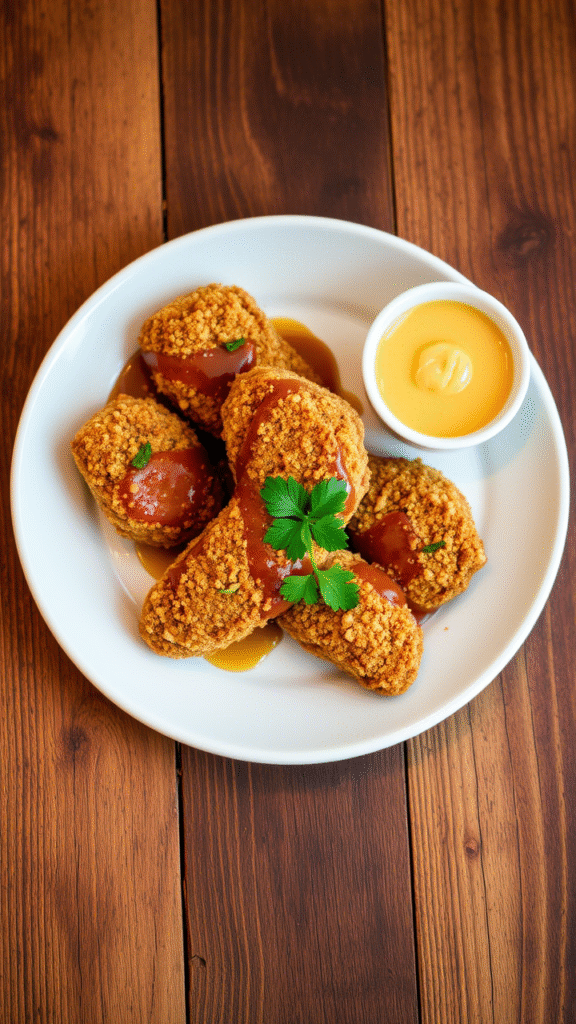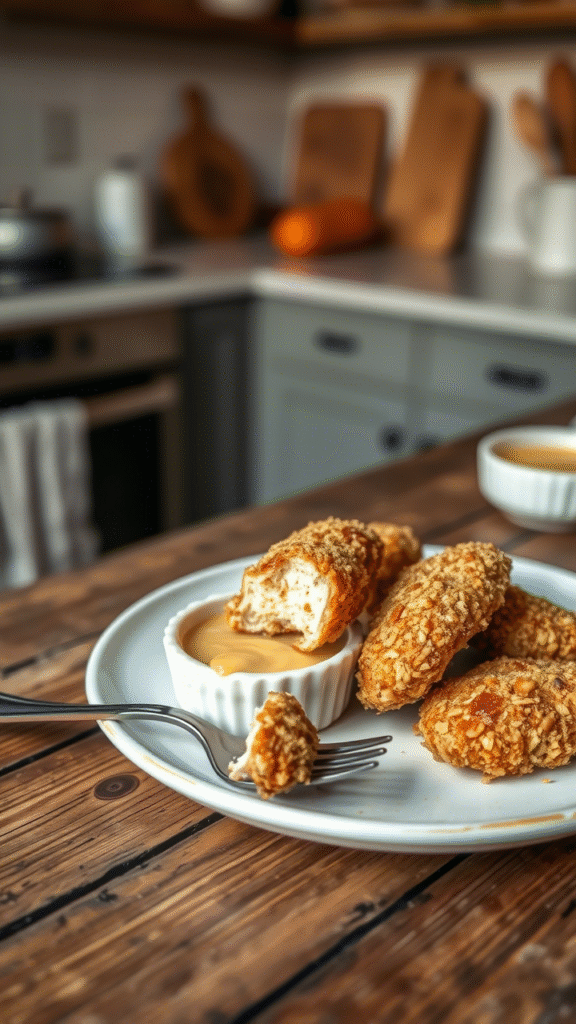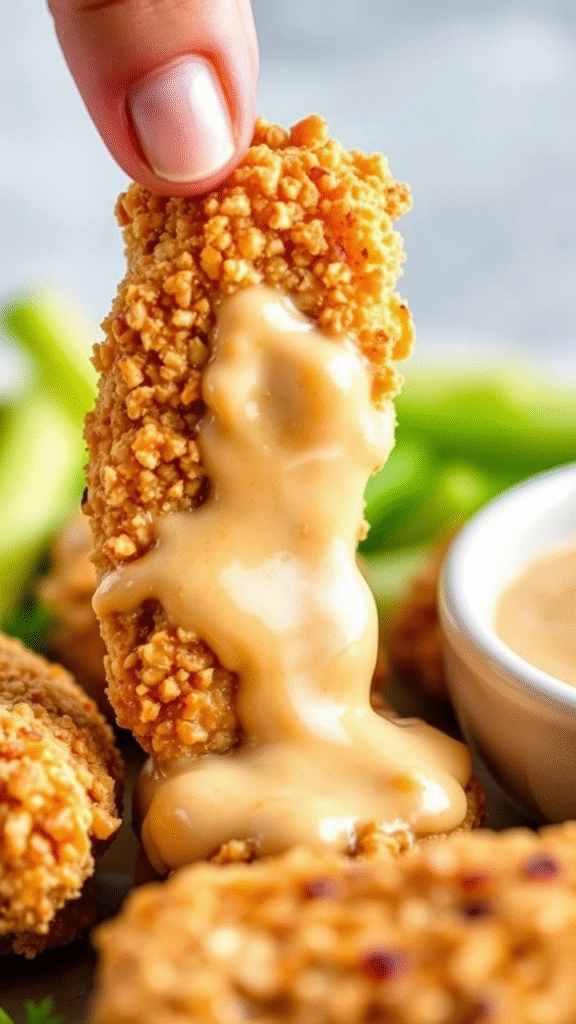A few years back, I served a plate of these maple walnut chicken tenders at a chef’s potluck. One guy—a stern sous chef from Quebec who hardly smiles—took a bite, paused, and muttered, “I don’t like sweet chicken… but I’d eat ten more of these.” That’s how this dish lands. Unexpected. Warm. A little indulgent. And impossible to stop eating.
Let’s be honest: Maple, walnuts, and chicken? That combo sounds like it wandered out of three different recipes. But that’s the magic here. You get crisp, nutty crusted chicken, sticky caramelized maple glaze, a touch of spice, and a buttery finish. It’s dinner masquerading as dessert, and it somehow just works. It’s playful, but grounded. You don’t serve this with ketchup. You serve it with a side of surprise and a crisp glass of something dry.
This is not your standard breaded tender. There’s a unique layering of texture and flavor—first the savory base of the chicken, then the crunch of toasted walnuts, and finally the rich, woodsy sweetness of real maple syrup, not that fake pancake stuff. Let’s break it all down like pros.
Ingredients & Substitutions

Here’s what you’ll need, but more importantly—here’s why you need it, and what to use if you can’t get it.
For the chicken tenders:
- 1.5 lbs chicken tenders (or chicken breast cut into strips)
Pro tip: Look for air-chilled chicken. Less water means better browning and more flavor. - 1 cup buttermilk
Sub: Use yogurt thinned with milk or even kefir. This is your flavor and moisture insurance. - 1 tsp smoked paprika
Adds warmth. Regular paprika works, but smoked gives depth. - ½ tsp garlic powder
- Salt & black pepper to taste
For the coating:
- ¾ cup all-purpose flour
Sub: Use chickpea flour for a gluten-free option with a nutty kick. - ½ cup crushed walnuts
Fresh walnuts only. If they smell stale, toss ’em. You’ll taste the difference. - ½ cup panko breadcrumbs
Panko gives the light crunch. Regular works in a pinch, but it’s heavier. - 1 tbsp cornstarch
Tiny trick: makes it crisp up faster and stay crispy longer.
For the glaze:
- ½ cup pure maple syrup (grade B is better—it’s darker, richer)
- 2 tbsp unsalted butter
- 1 tbsp Dijon mustard
This is what ties the sweetness back to savory. - 1 tsp apple cider vinegar
A splash of acid to cut the richness.
Optional but excellent:
- A pinch of cayenne (if you like heat)
- A touch of rosemary, very finely chopped, to add earthiness
Step-by-Step Instructions (With Chef-Level Insight)

1. Marinate the chicken.
Mix buttermilk, paprika, garlic powder, salt, and pepper in a bowl. Add the chicken, coat well, and let it sit. Minimum 30 mins, ideally overnight.
Why? The acidity breaks down protein just enough to keep it tender, and the buttermilk clings to the meat—key for holding your crust later.
2. Prep the coating.
In a separate bowl, combine flour, crushed walnuts, panko, cornstarch, salt, and a crack of pepper.
Tip: Don’t pulverize the walnuts. You want some texture. A mix of fine and coarse bits gives crunch and grip.
3. Bread the chicken.
Remove chicken from marinade, shake off excess, then dredge in the coating mix. Press firmly.
Expert note: Use the “wet hand, dry hand” trick to avoid clumpy fingers and uneven breading.
4. Chill the breaded tenders.
Pop them in the fridge for 15–20 mins before cooking.
This firms them up and helps the coating stick during frying. It’s a tiny step with huge payoff.
5. Fry or bake.
- Fry in 350°F oil (just enough to submerge) for 4–5 mins until golden.
- Bake at 425°F on a rack-lined sheet, drizzle with oil, flip halfway. Takes about 20–25 mins.
Air fryer? Absolutely. 390°F for about 15 mins, shaking once.
6. Make the glaze.
In a saucepan, melt butter. Add maple syrup, mustard, and vinegar. Simmer 2–3 mins until thickened slightly.
Do not boil hard—just a gentle bubble to marry the flavors.
7. Glaze the chicken.
Toss the hot tenders in a large bowl with the warm glaze. Or brush individually for more control.
Warning: If the chicken cools too much, the glaze won’t cling—it’ll just slide off.
8. Finish with flair.
Sprinkle a few extra chopped walnuts on top. Maybe a pinch of flaky salt. Optional: a tiny hit of cayenne or rosemary.
Cooking Techniques & Science Behind the Flavor
Let’s dig into the nerdy bit. Why does this recipe slap so hard?
Texture layering is everything. You get crunch from walnuts and panko, which toast beautifully during frying. The cornstarch absorbs surface moisture fast, giving a faster crust.
Searing, in oil or oven, sets the crust before juices escape. This locks in moisture. No soggy tenders here.
Acid + fat + sweet = the trifecta. Vinegar, butter, and syrup balance beautifully. The mustard emulsifies it so the glaze doesn’t split. It’s basic food chemistry—and when done right, it feels like sorcery.
Walnuts aren’t just for show. Toasted, they release oils that give a buttery depth to the crust. Skip them and you lose that soft richness under the crunch.
Use metal tongs instead of silicone. Why? Silicone cools too quickly and traps moisture. Metal lets steam escape, keeping things crisp.
Serving & Pairing Suggestions

Plating:
Pile them up on a wooden board. Drizzle a bit of glaze over the top, then scatter extra walnuts like you’re being careless (but you’re not). Add a sprig of rosemary or thyme for that chef-y look.
Pairings:
- Sides: Creamy mashed sweet potatoes. A crisp apple slaw. Roasted Brussels with bacon.
- Sauce: If you want a dipping sauce, go with a maple mustard aioli—heavy on the Dijon.
- Drinks: Dry white wines like Viognier or Gewürztraminer. A saison beer. For non-alcoholic, try a tart apple shrub or unsweetened iced tea with lemon.
Serve warm. But they’re weirdly good cold too. Like, next-day-over-the-sink good.
Why Maple Walnut Chicken Tenders Matter
Look, this isn’t a gimmick dish. It’s comfort food, yes—but layered with intention. Every ingredient has a reason, every technique has a purpose. You’re not just throwing together leftovers.
You’re creating contrast. Soft vs. crisp. Sweet vs. savory. Familiar vs. unusual.
That’s the heart of good cooking.
FAQs
1. Can I make these ahead of time?
Yes. Bread the chicken and refrigerate up to 24 hours ahead. Don’t glaze until ready to serve.
2. Are there nut-free options?
Use toasted sunflower seeds or skip the nuts entirely—just double the panko and season more heavily for extra flavor.
3. Can I use chicken thighs instead of tenders?
Absolutely. Cut into strips and adjust cook time slightly. Thighs are juicier, but can be a bit harder to bread evenly.
4. What if I don’t have buttermilk?
Add 1 tbsp vinegar or lemon juice to 1 cup milk. Let sit 10 minutes. Done.
5. Can I freeze these?
Yes—but freeze before glazing. Reheat in the oven or air fryer, then glaze fresh.

Food lover, recipe creator & the heart behind NoshCrafters.com. Olivia shares mouthwatering, easy-to-make dishes that turn everyday meals into unforgettable bites. When she’s not experimenting in the kitchen, she’s busy plating up inspiration for home cooks everywhere.